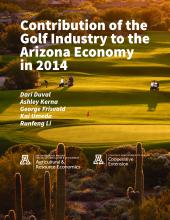Contribution of the Golf Industry to the Arizona Economy in 2014

Golf is an important part of Arizona’s economy and a defining component of the physical landscape of many of its cities and towns. Golf facilities support jobs and income for the state economy, indirectly support other Arizona businesses that serve and supply the facilities, drive tourist spending by attracting visitors from outside the state, and support sales by retailers offering golf equipment and merchandise to Arizona golfers. Additionally, golf facilities exert a positive effect on the value of residential real estate in their proximity. Meanwhile, golf courses require inputs year-round to maintain playable and attractive conditions for golfers on the facility’s turfgrass and other landscape surfaces. Major inputs include irrigation water, fertilizer, and other agricultural chemicals. Conservation efforts at golf facilities aim to balance the use of natural resources with the economic viability of the courses. This study provides an estimate of the economic contribution of the golf industry to Arizona’s economy in 2014, examining the following components: golf facility operations (operations spending, jobs, and other contributions), golf-related tourist spending, and golf-related business revenues. Other effects of the golf industry are not best measured using regional economic contribution analysis. These effects include the influence of golf courses on residential real estate values and natural resource use and conservation. The study provides an update to a 2004 estimate of residential real estate premiums attributable to frontage on and proximity to golf courses, and provides a snapshot of golf water use and conservation and management practices at Arizona golf facilities in 2014.

